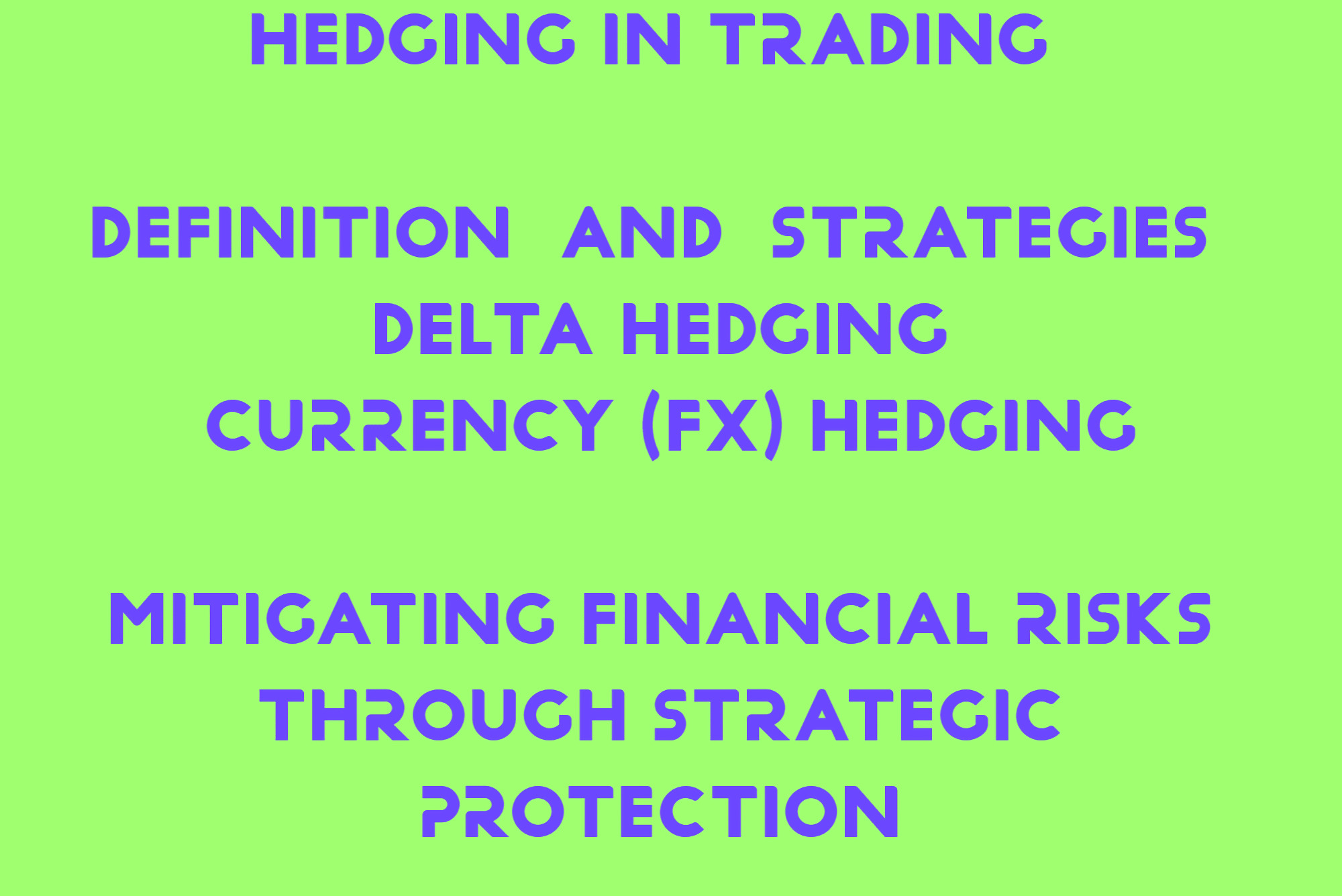Что такое хеджирование в трейдинге?
Хеджирование – это осуществление сделок с целью страхования и защиты активов от финансовых рисков..
Целью операций хеджирования является минимизация или компенсация потенциальной потери стоимости актива из-за неблагоприятных рыночных условий.. Хеджирование позволяет установить известную величину потенциальных убытков в случае снижения стоимости активов.. Существуют различные стратегии хеджирования..
Наиболее популярные из них связаны с использованием деривативов. – фьючерсы и опционы. Путем покупки реального актива и опциона пут на тот же актив по текущей цене., инвестор защищает свои инвестиции от снижения стоимости активов, ограничивая потери уплаченной премией.. Реальные поставщики сырьевых товаров использовали комбинации фьючерсных контрактов и опционов на аналогичные товары для защиты от ценовых рисков..
Диверсификация – стратегия хеджирования, основанная на формировании инвестиционного портфеля.. Эта стратегия предполагает распределение инвестиций инвестора по различным активам., часто используются комбинации акций из разных секторов или акций и облигаций в определенных соотношениях. Суть этой стратегии заключается в том, что при падении цены одного компонента портфеля, цены на другие могут вырасти, компенсация потерь.
Значение хеджирования в финансах
Хеджирование – это финансовая стратегия, направленная на снижение потенциальных рисков и защиту активов от неблагоприятных рыночных условий.. Он предполагает выполнение транзакций, которые действуют как страховые полисы., помогая минимизировать или компенсировать потенциальные потери стоимости активов. Используя методы хеджирования, инвесторы и предприятия могут ограничить свою подверженность волатильным колебаниям рынка и поддерживать определенный уровень финансовой стабильности..
Одним из наиболее распространенных методов хеджирования является использование деривативов., такие как фьючерсы и опционы. Производные финансовые инструменты — это финансовые инструменты, стоимость которых получена из базового актива.. Они предлагают инвесторам возможность застраховаться от потенциальных убытков путем заключения контрактов, обеспечивающих защиту в случае неблагоприятного движения цен..
Например, инвестор, который покупает реальный актив и одновременно приобретает опцион пут на тот же актив по его текущей цене, может защитить свои инвестиции от снижения стоимости актива. Если цена актива действительно упадет, убытки инвестора ограничиваются премией, уплаченной за опцион пут. Эта стратегия позволяет инвесторам установить заранее определенный уровень риска и защитить себя от неблагоприятных рыночных условий..
В сфере торговли сырьевыми товарами, реальные поставщики сырьевых товаров часто используют комбинации фьючерсных контрактов и опционов для защиты от ценовых рисков.. Используя эти производные инструменты, производители сырьевых товаров могут защитить себя от потенциальных колебаний цен на базовый товар.. Это позволяет им установить определенный уровень ценовой уверенности и защитить свою прибыльность..
Еще одна популярная стратегия хеджирования — диверсификация., который предполагает создание инвестиционного портфеля, охватывающего различные активы. Сущность диверсификации заключается в распределении инвестиций по различным секторам., классы активов, или комбинация акций и облигаций в определенной пропорции. Диверсифицируя свой портфель, инвесторы стремятся уменьшить свою подверженность каким-либо конкретным инвестициям и минимизировать потенциальные потери..
Идея диверсификации заключается в том, что когда цена одного компонента портфеля падает,, цены на другие активы могут вырасти, помогаем компенсировать потери. Например, если инвестор владеет акциями разных компаний в разных секторах, снижение стоимости одной акции может быть уравновешено ростом других акций в портфеле. Диверсификация позволяет инвесторам снизить общий риск и защититься от волатильности отдельных активов..
Важно отметить, что стратегии хеджирования могут различаться в зависимости от конкретных целей., толерантность к риску, и инвестиционный горизонт индивидуальных инвесторов или предприятий. Хотя деривативы и диверсификация являются двумя широко используемыми методами, существует множество других методов хеджирования, включая опционные стратегии, форвардные контракты, и биржевые фонды (ETF), среди прочего.
В заключение, хеджирование играет решающую роль в управлении финансовыми рисками и защите активов от неблагоприятных рыночных условий.. Будь то использование деривативов или стратегии диверсификации., инвесторы могут эффективно смягчить потенциальные потери и поддерживать определенный уровень финансовой стабильности.. Используя эти методы хеджирования, частные лица и предприятия могут с большей уверенностью ориентироваться в нестабильной рыночной среде и защищать свои инвестиции..
Определение хеджирования
Стратегии хеджирования
Смягчение финансовых рисков посредством стратегической защиты
В постоянно меняющемся ландшафте финансовых рынков, инвесторы и предприятия сталкиваются с множеством рисков, которые могут повлиять на стоимость их активов. В такой нестабильной обстановке, концепция хеджирования возникла как стратегический инструмент защиты от потенциальных потерь и обеспечения определенного уровня страхования.. Хеджирование предполагает выполнение операций, направленных на минимизацию или компенсацию вероятной потери стоимости активов в результате неблагоприятных рыночных условий.. Он предлагает отдельным лицам и организациям возможность перемещаться по неопределенной местности с большей уверенностью и финансовой стабильностью..
Основная цель операций хеджирования — защититься от потенциальных убытков и ограничить воздействие неблагоприятных движений рынка.. Используя стратегии хеджирования, инвесторы могут зафиксировать сумму потенциальных убытков до известного значения, тем самым уменьшая неопределенность и сохраняя капитал. Существуют различные стратегии хеджирования., каждый из них предназначен для устранения конкретных рисков и достижения различных инвестиционных целей..
Один из наиболее широко используемых подходов к хеджированию предполагает использование деривативов., особенно фьючерсы и опционы. Производные финансовые инструменты — это финансовые инструменты, стоимость которых получена из базового актива.. Эти инструменты предоставляют инвесторам возможность застраховаться от потенциальных убытков путем заключения контрактов, обеспечивающих защиту в случае неблагоприятного движения цен..
Рассмотрим инвестора, который покупает реальный актив и одновременно приобретает опцион пут на тот же актив по его текущей цене.. При этом, они создают защиту от потенциального снижения стоимости актива. Если цена актива действительно снижается, убытки инвестора ограничиваются премией, уплаченной за опцион пут. Эта стратегия хеджирования позволяет инвесторам установить заранее определенный уровень риска и защитить себя от неблагоприятных рыночных условий..
Реальные поставщики сырьевых товаров также часто используют комбинации фьючерсных контрактов и опционов для защиты от ценовых рисков.. Используя эти производные инструменты, производители сырьевых товаров могут защитить себя от потенциальных колебаний цен на базовый товар.. Это позволяет им установить уровень ценовой уверенности., обеспечение стабильности своей деятельности и сохранение прибыльности.
Еще одна популярная стратегия хеджирования — диверсификация., который предполагает создание инвестиционного портфеля, состоящего из различных активов. Диверсификация направлена на распределение инвестиций по различным секторам., классы активов, или комбинация акций и облигаций в определенных пропорциях. Основополагающий принцип диверсификации заключается в уменьшении воздействия какой-либо конкретной инвестиции и смягчении потенциальных потерь..
Через диверсификацию, когда цена одного компонента портфеля падает, прибыль от других активов в портфеле может компенсировать убытки. Например, инвестор, владеющий акциями разных компаний в разных секторах, может столкнуться со снижением стоимости одной акции. Однако, если другие акции в портфеле вырастут в цене, это помогает компенсировать понесенные потери. Диверсификация выступает в качестве инструмента управления рисками., позволяя инвесторам минимизировать влияние волатильности отдельных активов и защититься от концентрированных рисков.
Важно отметить, что стратегии хеджирования могут различаться в зависимости от индивидуальных целей., толерантность к риску, и инвестиционный горизонт. Хотя деривативы и диверсификация являются двумя широко используемыми методами, существует множество других методов хеджирования. К ним относятся опционные стратегии, форвардные контракты, биржевые фонды (ETF), и более, каждый со своими преимуществами и соображениями.
В заключение, хеджирование играет жизненно важную роль в управлении финансовыми рисками и защите активов в динамичной и непредсказуемой рыночной среде.. Будь то использование деривативов или стратегии диверсификации., инвесторы могут эффективно смягчить потенциальные потери и поддерживать определенный уровень финансовой стабильности.. Используя эти методы хеджирования, частные лица и предприятия могут с большей уверенностью ориентироваться в турбулентных рыночных условиях и защищать свои инвестиции от непредвиденных обстоятельств.. Поскольку финансовый ландшафт продолжает развиваться, важность хеджирования как инструмента стратегического управления рисками остается неизменной.

Дельта-хеджирование
Управление рисками посредством динамической корректировки портфеля
В мире финансов, управление рисками является важнейшим аспектом успешного инвестирования. Одним из методов, получивших известность, является дельта-хеджирование., стратегия, используемая для снижения риска изменения цен на производные финансовые инструменты по отношению к их базовым активам.. Используя дельта-хеджирование, инвесторы могут эффективно управлять рисками и поддерживать сбалансированный портфель в условиях волатильности рынка.. Целью этой статьи является предоставление всестороннего понимания дельта-хеджирования и его применения в управлении рисками..
Дельта, часто обозначается греческой буквой Δ, является мерой чувствительности цены опциона к изменениям цены его базового актива.. Он указывает на степень изменения цены опциона в ответ на изменение цены базового актива.. Дельта 1 означает движение один к одному, где цена опциона будет увеличиваться или уменьшаться одновременно с ценой базового актива. Дельта 0.5 предполагает, что цена опциона изменится вдвое меньше, чем цена базового актива..
Что такое Дельта Хеджирование?
Дельта-хеджирование предполагает создание позиции в базовом активе, которая компенсирует дельта-риск производного инструмента.. Основная цель — построить портфель, в котором изменения стоимости опциона компенсируются соответствующими изменениями стоимости базового актива., что приводит к нейтральной к риску позиции.
Чтобы выполнить дельта-хеджирование, инвестор предпримет следующие шаги:
- Определить дельту опциона: Дельта-стоимость опциона может быть получена из моделей ценообразования или торговых платформ.. Он отражает чувствительность стоимости опциона к изменениям цены базового актива..
- Рассчитайте количество вариантов хеджирования: Чтобы нейтрализовать воздействие дельты, инвестору необходимо определить количество вариантов хеджирования. Это делается путем деления дельты опциона на дельту базового актива.. Например, если опцион имеет дельту 0.6 а базовый актив имеет дельту 1, инвестору придется хеджировать, покупая или продавая 0.6 базовые активы для каждого опционного контракта.
- Скорректируйте портфолио: После того, как количество вариантов хеджирования рассчитано, инвестор внесет необходимые коррективы в свой портфель, соответственно купив или продав базовый актив.. Эта динамическая корректировка гарантирует, что изменения стоимости опциона компенсируются изменениями стоимости базового актива., эффективное хеджирование риска дельты.
Дельта-хеджирование чаще всего используется в контексте торговли опционами., где цель состоит в том, чтобы нейтрализовать дельта-риск опционной позиции. Путем динамической корректировки портфеля в зависимости от изменений дельты, инвесторы могут сохранять нейтральную к риску позицию и снижать свою подверженность колебаниям цен на базовый актив..
Эффективность дельта-хеджирования зависит от нескольких факторов., включая точность оценки дельты, транзакционные издержки, ликвидность базового актива, и временная чувствительность вариантов. Важно отметить, что дельта-хеджирование не является надежной стратегией и не может устранить все риски.. Однако, он может значительно снизить влияние движения цен и обеспечить определенную стабильность портфеля..
Дельта-хеджирование особенно актуально на рынках с высокой волатильностью или при работе со сложными деривативами.. Это позволяет инвесторам динамически управлять рисками., адаптация к меняющимся рыночным условиям и обеспечение соответствия их портфеля их толерантности к риску и инвестиционным целям..
В заключение, Дельта-хеджирование — это мощный метод управления рисками, который помогает инвесторам преодолевать неопределенности на рынках производных финансовых инструментов.. Компенсируя дельта-риск опционов посредством динамических корректировок базового актива., инвесторы могут занять нейтральную к риску позицию и минимизировать влияние движения цен.. В то время как дельта-хеджирование требует тщательного мониторинга и корректировки, он предлагает эффективные средства управления рисками и поддержания сбалансированного портфеля. Поскольку инвесторы продолжают искать стратегии для защиты своих инвестиций, дельта-хеджирование остается ценным инструментом в их арсенале.
Базовый пример дельта-хеджирования
| Позиция | Дельта | Направленное смещение | Ожидаемая прибыль/убыток на $1 Изменение цены акций |
|---|---|---|---|
| Б | -3,000 | Медвежий | -$3,000 |
| После хеджирования | -1,500 | Менее медвежий | -$1,500 |
Объяснение: В таблице обобщена информация, связанная с позицией и влиянием хеджирования на направленный риск..
- Позиция B изначально имеет дельту -3,000, указывает на медвежий уклон. Это означает, что позиция, как ожидается, принесет прибыль $3,000 когда цена акций упадет $1 и ожидается, что он проиграет $3,000 когда цена акции увеличится на $1.
- Чтобы уменьшить направленное воздействие позиции, трейдер решает добавить стратегии положительной дельты. Они предпочитают покупать акции в качестве хеджирования..
- Чтобы снизить направленный риск на 50%, трейдер рассчитывает, что им нужно купить 1,500 акции. Каждая акция имеет дельту +1, что означает покупка 1,500 акции добавят 1,500 дельты в положение.
- Как результат, новая дельта позиции становится -1,500, уменьшение медвежьего предубеждения. С этой скорректированной дельтой, ожидается, что трейдер потеряет $1,500 если цена акции увеличится на $1. Это представляет собой 50% уменьшение ожидаемого убытка по сравнению с первоначальным -$3,000 убыток на $1 рост цены акций.
Таблица помогает визуализировать влияние хеджирования на направленность позиции и ожидаемую прибыль/убыток за единицу. $1 изменение цены акции.
Валютное и валютное хеджирование
Защита от валютного риска
Во все более глобализированном мире, предприятия, инвесторы, и физические лица подвергаются неотъемлемым рискам, связанным с иностранной валютой. (Форекс) колебания. На стоимость валюты влияет множество факторов., в том числе экономические показатели, геополитические события, и рыночные настроения. Как результат, необходимость в эффективных валютных и валютных стратегиях хеджирования стала первостепенной. Целью этой статьи является предоставление всестороннего понимания валютного и валютного хеджирования., их значение, и различные стратегии, используемые для управления валютным риском.
Валютное хеджирование — это упреждающий подход, используемый отдельными лицами и организациями для защиты от потенциальных потерь, возникающих из-за неблагоприятных колебаний обменных курсов.. Цель состоит в том, чтобы смягчить неопределенность и сохранить стабильность денежных потоков и финансовых прогнозов.. Стратегии валютного хеджирования особенно важны для предприятий, занимающихся международной торговлей., транснациональные корпорации, и инвесторы с иностранными инвестициями. Хеджируя валютный риск, эти организации могут защитить свою прибыль, затраты, и инвестиции из-за волатильности валютных рынков.
Одним из наиболее распространенных методов валютного хеджирования является использование форвардных контрактов.. Форвардные контракты — это соглашения между двумя сторонами об обмене определенной суммы валюты в заранее определенную дату в будущем и по обменному курсу.. Зафиксировав обменный курс, предприятия могут устранить риск неблагоприятного движения валютных курсов. Это обеспечивает уверенность в денежных потоках., защищает размер прибыли, и способствует точному составлению бюджета и финансовому планированию.
Валютные опционы — еще один популярный инструмент валютного хеджирования.. Валютные опционы дают держателю право, но не обязанность, купить или продать определенное количество валюты по заранее определенной цене в течение определенного периода времени. Эти варианты обеспечивают гибкость и позволяют предприятиям и инвесторам ограничить риск ухудшения ситуации, потенциально извлекая выгоду из благоприятных колебаний валютных курсов.. Валютные опционы можно использовать для хеджирования как ожидаемых, так и непредвиденных колебаний валютных курсов., предоставление эффективных средств управления рисками.
Помимо форвардных контрактов и опционов, валютные свопы широко используются в стратегиях хеджирования на валютном рынке.. Валютные свопы предполагают обмен основной суммы долга и процентных платежей в разных валютах между двумя сторонами.. Данные соглашения позволяют контрагентам управлять своими денежными потоками., хеджировать валютный риск, и оптимизировать затраты на финансирование. Валютные свопы обычно используются транснациональными корпорациями., финансовые учреждения, и инвесторы, участвующие в трансграничных сделках.
Фьючерсные контракты также используются при хеджировании валютных рисков.. Эти стандартизированные соглашения о покупке или продаже определенного количества валюты в заранее определенную дату и цену в будущем торгуются на организованных биржах.. Фьючерсные контракты обеспечивают прозрачность, ликвидность, и стандартизированные условия, что делает их привлекательными для валютных трейдеров и инвесторов, стремящихся хеджировать свои позиции и управлять валютным риском в своих портфелях..
Структурированные продукты предлагают индивидуальный подход к хеджированию валютных рисков путем объединения различных производных инструментов.. Эти продукты адаптированы к конкретным профилям рисков и целям предприятий и инвесторов.. Структурированные продукты могут включать опционы., вперед, свопы, и другие производные инструменты для предоставления комплексных решений по управлению валютными рисками. Они обеспечивают гибкость при разработке стратегий хеджирования и могут быть структурированы таким образом, чтобы смягчить конкретные риски и одновременно оптимизировать потенциальную прибыль..
Важно понимать, что стратегии валютного и валютного хеджирования не полностью устраняют валютный риск.. Хеджирование предполагает затраты, такие как комиссионные за транзакции и потенциальные альтернативные издержки. Кроме того, точное предсказание движения валюты является сложной задачей, и решения по хеджированию должны основываться на тщательном анализе, оценка риска, и рассмотрение желаемых финансовых результатов.
В заключение, Стратегии валютного и валютного хеджирования играют жизненно важную роль в управлении рисками, связанными с колебаниями валютных курсов.. За счет использования форвардных контрактов, валютные опционы, валютные свопы, фьючерсные контракты, и структурированные продукты, предприятия, инвесторы, и люди могут эффективно защитить себя от неблагоприятных колебаний валютных курсов.. Путем реализации соответствующих стратегий хеджирования, они могут ориентироваться в сложностях международной торговли, инвестиции, и финансовое планирование с большей уверенностью и стабильностью.

-
“Раскрытие возможностей хеджирования: Стратегии и методы финансовой защиты”
-
“Хеджирование 101: Комплексное руководство по снижению финансовых рисков”
-
“Изучение преимуществ хеджирования: Защита ваших инвестиций в нестабильные времена”
-
“Освоение стратегий хеджирования: Глубокое погружение в производные финансовые инструменты, Диверсификация, и многое другое”
-
“Хеджирование демистифицировано: Понимание искусства балансирования риска и вознаграждения”
-
“Построение прочной финансовой крепости: Как хеджирование может защитить ваше богатство”
-
“Роль хеджирования в Инвестиционные портфели: Повышение стабильности и производительности”
-
“Раскрыты методы хеджирования: Понимание вариантов, Фьючерсы, и дальше”
-
“Достижение финансовой устойчивости посредством эффективных стратегий хеджирования”
-
“Управление волатильностью рынка: Использование силы хеджирования для долгосрочного успеха”


